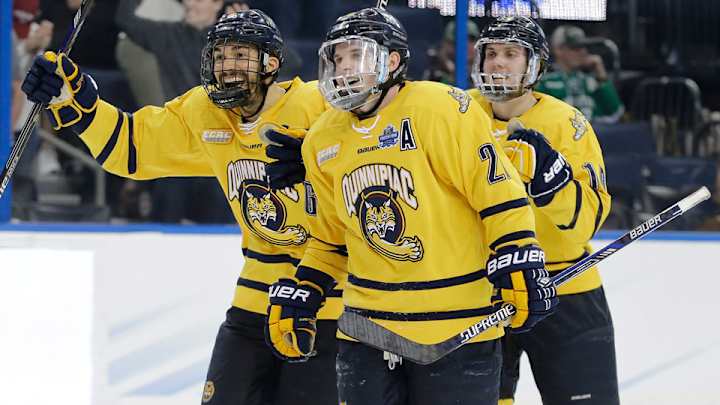Frozen Four: Quinnipiac beats Boston College, advances to championship

TAMPA, Fla. —The schools’ hockey heritage couldn’t be more different. For Boston College, its the Eagles’ 25th appearance in the Frozen Four, the most of any program. Quinnipiac, which moved into Division I hockey in 1998, was skating in just its second Frozen Four.
That didn’t matter much Thursday, as the Quinnipiac Bobcats punched a ticket to the national championship with a 3–2 win over the Boston College Eagles.
1. Special teams matter in an elimination game
It goes without saying that special teams matter, but it loomed large during Thursday’s game. When little was working for Boston College, it needed to take advantage of some ill-advised Quinnipiac penalties. Yet, the Eagles were ineffective in their efforts to turn the tide, putting just a single shot on net through three power plays in the first two periods.
The Quinnipiac Way: How a college hockey power was born
The Quinnipiac penalty kill was dominant when it mattered most. The Bobcats finally allowed a power-play goal late in the third to see Boston College come within one, but killed off five of six penalties in the end.
“Our [penalty kill] is better than we showed tonight,” said coach Rand Pecknold. “But it was good enough.”
Judging a team by special teams coming into the match is a usually a risk, but Quinnipiac’s penalty kill was key to its victory, as was a timely power-play goal.
Going forward, it means the Bobcats’ opponent in the national championship can’t bank on getting its power play going. For Quinnipiac, it will also need to get the penalties under control. Tim Clifton took three penalties, including the third-period penalty that turned into a Boston College goal.
2. Quinnipiac owns the center of the ice
Quinnipiac’s defensive structure was able to suck the life out of any push Boston College could muster. The Eagles were kept to the outside in the attacking zone and centering passes were unsuccessful, particularly in the first and third periods.
Minnesota wins second straight Frozen Four, ends BC’s perfect season
Even more impressive was the way Quinnipiac shut down the neutral zone in the first half of the third period. Boston College couldn’t find its way into the zone with speed or control, which shortened the time it had to find a late push.
On the power play, the center of the ice was owned by Quinnipiac. If Boston College tried to drive the puck through the blockade, shots were stopped by defenders or goaltender Michael Garteig swallowed up the rebounds. Garteig finished the game with 34 saves.
It wasn’t until the last half of the third period that Boston College was able to get start getting pucks into and through the center of the ice, but it was too little, too late.
3. Boston College beat themselves
The Bobcats’ defense was strong and their special teams were clearly better, but Boston College beat itself. The Eagles struggled getting shots on net to open the game, coming out slow and failing to find their stride. Trying to explain it after the game, forward Steve Santini said, “It’s normal to be a little nervous.”
It took 5:56 for Boston College to get its first shot, and its third shot came over 13 minutes in.
Watch NCAA hockey tournament: Game times, live stream, TV
Quinnipiac certainly deserves a lot of credit, but Boston College looked beat as soon as Kevin McKernan scored just 2:31 into the game. Giving up two goals in the first 7:20 sunk Boston College’s fire.
The Eagles pushed back well to start the second period, with Alex Tuch scoring 23 seconds in, but a Quinnipiac goal four minutes later helped to power down the Boston College attack.
Boston College outshot Quinnipiac in the second, but it never really felt like there was really a chance the Bobcats were going to start a rally. Shots came from the outside, the power play generated little, and they rarely managed to get much pressure in front of Garteig, whose rebound control was strong.
Coming out in the third, there was little urgency to Boston College’s game. In the first half of the period the Eagles managed just two shots. A lot of the Eagles’ struggles were a result of Quinnipiac’s defensive play, but Boston College wasn’t playing like a team that could compete with Quinnipiac until late in the game.
While Boston College boasts as much individual talent as any school, the team play wasn’t enough to get past a Quinnipiac squad that showed a well-rounded game deserving of its No. 1 rank.
